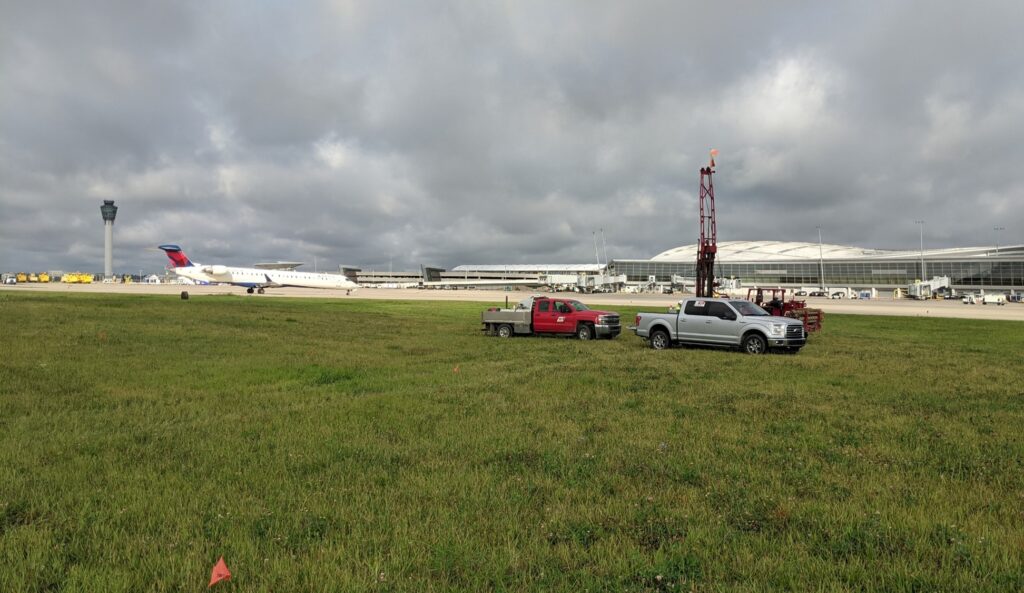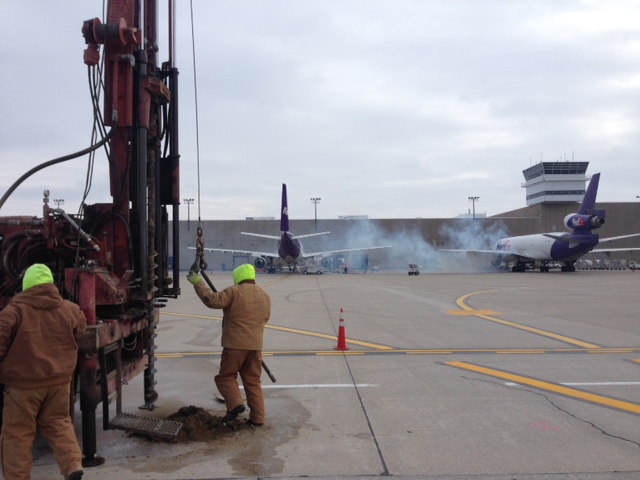Five reasons why aviation experience matters
Within minutes of leaving the job site, an airplane lands in the exact spot where engineers stood only moments ago. But you would never know the team had been there. In this high-stakes world, leftover debris can cost lives.
After 15 years of working on more than 250 projects in the aviation industry, CTL Engineering has become an expert on the logistics and techniques necessary to work at airports. Rarely is job site planning and coordination as crucial as it is at an airport.
In a world where details matter, having the right expertise on your team is crucial. Between the complicated logistics of working on a runway, taxiway, apron, or other areas of an airfield; understanding potential pavement problems long before they arise; or properly addressing existing issues; the right experience can make the project a smooth one.
Particularly in today’s environment where there is heavy competition for limited funds, hiring an experienced engineer becomes even more critical to airport stakeholders.
Below are five reasons why working with an engineer experienced in aviation matters.
1. Safety First
Working in and around an active airfield can inherently be dangerous. CTL engineers strictly adhere to FAA Advisory Circular 150/5370-2 “Operational Safety on Airports During Construction” and local airport operations protocols. The Advisory Circular addresses general aviation airport safety, runway safety, airports certificated under 14 Code of Federal Regulations Part 139, and safety management systems (SMS).
2. Airport Logistics Are Complicated
CTL offers a variety of aviation experience, including:
- Existing Pavement evaluations
- Environmental due diligence,
- Geotechnical engineering,
- Construction Inspection and Administration
- Quality assurance and materials testing,
- and Quality control.
In all of these categories, logistics and proper planning are crucial. Before a project ever begins, permits to access the site must be in place, including proposed field explorations plans, proposed personnel, and utility coordination. Coordination with airport operations for badging (when required) and Escorts on and off the airfield must also be arranged. While on-site, engineers must maintain communication with both control towers and operations staff. Safety is the number one priority.
Take a runway rehabilitation, for example. Shutting a runway down takes a significant amount of coordination from airport staff. The runway won’t be shut down for longer than necessary. Within minutes of the scheduled reopening, planes will be circling overhead, ready to land.
By the time staff are in the field, there is no room for error. CTL’s experienced staff have this down to a science.
CTL provides services to commercial and general aviation airports and military bases – both on the air and land sides – and each project requires its own logistics. From airfield pavements, terminals and parking garages, hangars, stormwater control to de-icing facilities and fire stations, an experienced engineer understands how to work with airport staff. Experience ensures the logistics are uncomplicated and easy for the client.
3. New Technologies Can Save Airports Time and Money
Every day, new technologies are developed to serve aviation clients better.
Recently, CTL has begun using geophysical studies to map sub-surface conditions before a project starts. Doing so can help identify problematic conditions at the start of the project – ranging from bedrock and underground aquifers to various subsurface anomalies, such as karst, voids, and variability of the rock surface.
By sending an electrical current into the ground using a series of metal pins (electrodes) and a long cable, CTL can measure the resistivity of the ground and help identify the different soil/rock layers to depths of 100 feet or more.
This is useful in determining what type of excavation methods and foundations are needed – such as piling versus drilled shafts – before a project is designed, reducing the number of surprises and change orders a client can expect. In aviation, identifying underground aquifers, depths to rock, or caves can be critical under runways or other critical structures.

4. Knowledge of FAA Advisory Circulars
Although FAA Advisory Circulars, which provide guidance for compliance on any aviation design, are available to anyone – having intimate knowledge of the circulars helps make a project run smoother from start to finish.
CTL is familiar with these circulars on everything from spacing and depths of borings to which tests should be performed and data collected. Understanding the advisory circulars helps guarantee that the consultant won’t skip procedures or miss information or data.
Experienced engineers know when to consult FAA circulars and interpret them to provide information that benefits the project.
5. Ongoing Maintenance and Planning
Finally, an experienced engineer doesn’t just bring value during the construction process. Proper planning can also ensure thoughtful maintenance and reduce long-term costs.
Short and Long-Term planning for airfield pavements is critical in forecasting for existing maintenance and also proposed expansions. CTL assists in the execution of pavement maintenance programs for both the Indianapolis International Airport Authority and the Columbus Regional Airport Authority. These programs assist the airports in understanding the current condition of their pavement and how to budget and plan for future maintenance.
In addition to a visual inspection, engineers gather historical records and assess for potential problems. The result is an extensive collection of data for the airport to understand its current assets.
By taking corrective actions to any potential problems early, airports can often save costs and better plan for the future. CTL excels at providing accurate engineering data, including good engineering recommendations during both design and construction phases.
Expertise Limits Surprises
CTL has completed more than 250 airport projects, including work for the Indianapolis Airport Authority, Cincinnati/Northern Kentucky International Airport, the Columbus Regional Airport Authority, Akron-Canton Airport, Morgantown West Virginia Municipal Airport, to name a few. CTL has also serviced numerous General Aviation Airports across the region, becoming a leading airport consultant.
And while experience makes the project run smoother, ultimately, it’s the quality of the work – specifications that reduce surprises in the field and limit the possibility of a change order, projects that finish on time and budget, and second-to-none quality – that keeps clients returning.
To learn more about CTL’s aviation expertise in Ohio, Indiana, Kentucky, Pennsylvania, Virginia, and West Virginia, complete the “Ask the Expert” form below.

